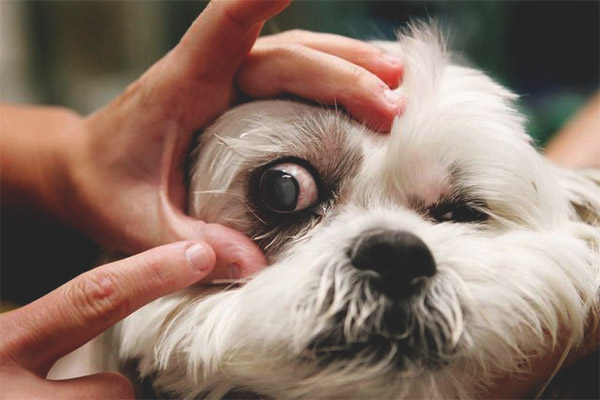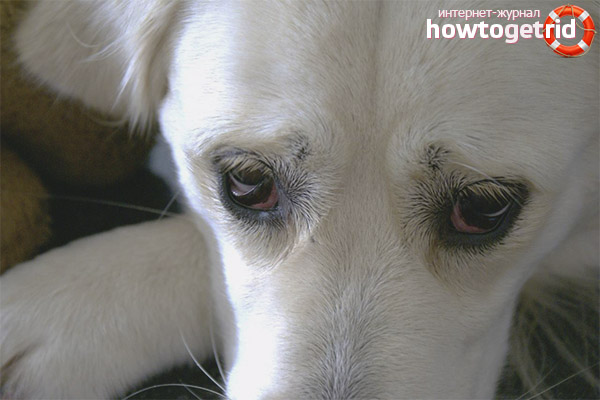The content of the article
The eyes of a person are a mirror of the soul, and the eyes of a dog for a person are a pet's health identifier. However, they are also sensitive to external irritants. They instantly react to ingress of dust, dust and pathogenic bacteria into them. As a result of contact with the above listed irritants, inflammation in the form of itching, photophobia and even purulent discharge may occur. The main factors provoking the development of eye diseases in dogs are the ingress of small insects or foreign objects, allergic reactions, viruses, and physical pathologies.
The reasons
In simple words, conjunctivitis is an inflammatory process that occurs in the mucous membrane of the eye and eyelids.
The causes of the disease in dogs are as follows:
- Dust, smoke, winding.
- Irritation by chemicals: ointments, shampoos, soaps, home cleaning products, etc.
- Diseases of the eyes and lacrimal glands.
- Infections of bacterial, viral, fungal origin.
- Individual allergic reactions, for example, of a seasonal nature.
- Contact with the mucous membrane of the eye of foreign objects: dirt, dust, insects.
- Injuries to the mucous membranes of the eye.
Many eye diseases are specific to certain breeds of dogs. They are genetically determined and are their physical features. Small animals are usually predisposed to cataract diseases and retinal detachment. Large breeds of dogs are prone to diseases such as turning the lower eyelid. Such a pathology is the cause of persistent conjunctivitis, which is provoked by contact with dirt and dust in the eyes. Some individuals due to the structure of the eyelids are prone to constant penetration into the eye of various small particles. Certain breeds have the structure of the eyelids, when the eyelashes are curved in the middle, and this is the cause of permanent injury to the eye mucosa. For example, chow - chow, hounds, Pekingese and others. In most situations it is quite possible to solve the problem conservatively, but there are cases when surgical intervention cannot be avoided.
Important! Transition of the disease to a chronic form and visual impairment, including total blindness, can be a consequence of incorrectly or not at the time treated conjunctivitis in a dog.
Signs of
The most common disease affecting the eye area in dogs is conjunctivitis. You can suspect it by watching the following signs in your pet:
- visible inflammatory processes in the mucous membranes of the eyes;
- discoloration of the eyelids (redness);
- profuse tearing;
- itching;
- the presence of purulent discharge;
- photophobia;
- limited ability to blink and open eyes.
Similar symptoms may occur in other diseases. For this reason, it is possible to make sure that the animal suffers from conjunctivitis, in the presence of pronounced symptoms:
- In order to understand what causes the pet to have a heavy tearing, it is necessary to carefully examine the eye for the presence of foreign objects in it - small particles.
- Inflammatory processes on the mucous membranes of the eyes, as a rule, are accompanied by photophobia. With this pathology, the animal in every way avoids exposure to the sun, closes its eyes or tilts its head.
- Conjunctivitis is accompanied by severe itching.What the animal says about it is that the animal tries to scratch the eye with its paws, rubs them against different objects, blinks hard, shakes its head and is nervous.
Important! Attempts to overcome itching can cause injury to the eye, which is highly undesirable. Therefore, it is necessary to deal with it with the help of special anesthetics and antihistamines, selected by a qualified veterinarian after the appropriate diagnosis.
Varieties of the disease
Taking into account the causes of the disease and the forms of its course, there are several varieties of this disease. There are three most common forms:
- Purulent.
- Follicular
- Catarrhal
- Phlegmonous.
Purulent conjunctivitis
This disease is triggered by pathogenic aerobic bacteria, often streptococci or staphylococci. They penetrate the mucous membranes through the damaged areas. For this reason, this form is due to follicular or allergic conjunctivitis in the absence of adequate therapy. Pathogens contribute to the development of inflammatory processes and purulent secretions.Its main distinguishing symptoms are fever in the area of the eyelids of the animal and photophobia.
Follicular conjunctivitis
The development of follicular conjunctivitis is most often triggered by allergic reactions. Dogs, like people, during the period of allergic manifestations suffer from inflammation, itching, redness and tearing of the eyes. Such reactions are observed in the warm periods of the year, during the flowering of various plants - possible allergens.
Conjunctival follicles are inflamed. This inflammation is accompanied by swelling and redness. Sometimes the development of follicular conjunctivitis contributes to the presence of problems with the eyeballs and the third century. The third eyelid also contains follicles that are prone to edema and inflammation.
Do not ignore the tearing, the presence of redness and itching in an animal. With such symptoms, it is advisable to seek qualified help. Treatment in the early stages, when the disease is just beginning to develop and has minimal manifestations - the key to complete recovery with minimal time and money.In the later stages, the disease progresses, the discharge acquires a purulent consistency, form crusts, which cause the dog very strong discomfort.
Catarrhal conjunctivitis
This form of the disease is accompanied by excessive tearing, swelling, redness of the mucous membranes of the eyes. Its course can be acute or chronic. As a rule, the last variant is preceded by an acute course, when the disease has pronounced productive symptoms in active manifestation. Late medical care or lack of it becomes the cause of the development of the chronic form. And chronic forms of the disease have a long course and are difficult to treat.
Phlegmonous conjunctivitis
This form of the disease is rather a complicated form of all the previous ones. Its main symptom is inflammation of the glassy surface of the mucous membrane of the eyes, convexity of the conjunctiva, the presence of abundant serous and purulent secretions, the appearance of ulcers.
Important! The consistency of purulent discharge can determine the severity of the disease. If it is thick, it means that the content of leukocytes in it is maximum.And, accordingly, the body independently fights infection. The liquid consistency of pus indicates a severe disease.
Treatment and diagnosis
Before proceeding with the treatment of such a disease, it is necessary to diagnose the state of health of the pet in a veterinary clinic, as well as to determine the provoking factors. The doctor is collecting anamnesis, internal examination of the animal. Additionally, clarifying analyzes can be assigned.
The main task of the attending physician is to determine the causative agent of the disease. To do this, take samples from the pathological secretions of the eyes to determine their nature. They are sown in a nutrient medium. After the culture of microorganisms grows, they are examined with the help of optical devices, for example, a microscope. In the end, the same culture is used for the selection of medicines, determining its sensitivity to one or another kind of drugs.
Anti-inflammatory, antihistamine, antibacterial drugs, as well as antiseptics are prescribed for treatment. Pain relievers may be prescribed to relieve itching and pain.
The follicular form sometimes requires surgical treatment, which consists in cauterizing the follicles. Self-treatment in this case is unacceptable. Often, the owners can not cope with the disease on their own, and use inappropriate medicines, thereby enabling the disease organisms to continue to develop. In this case, the course of the disease becomes more complicated and the owner requests qualified help even when the state is sufficiently neglected.
In the treatment of conjunctivitis, etazolovy, sulfacyl - sodium and tetracycline ointments have positively manifested themselves. In the presence of large edema, a mixture of dexazone, hydrocortisone and novocaine is injected under the conjunctiva.
Of the newest drugs, it is worth noting special eye medicinal films developed by E. Kopenkin. They contain the following active ingredients: sulfapyridazine - sodium, neomycin, kanamycin - they are introduced into the region of the conjunctival sac with anatomical tweezers 1-2 times a day. They adhere to the conjunctiva with the help of tearing and, gradually dissolving, release medicinal substances.This method of treatment has a very high positive effect.
Often, to achieve good efficacy, treatment methods are selected by trial and error individually. For the period of treatment, more than ever, it is important to maintain animal hygiene and constant eye treatment with weak antiseptic solutions using 3% boric acid and novocaine 0.25%.
Important! So that the pet does not hurt his eyes in an attempt to scratch them, it is advisable to use the so-called "Elizabethan collar."
Preventive measures
Several times a week, it is required to carefully examine the pet's eyes for the presence of foreign objects, wool, specks and black flies. Once every few days, wipe them with a cotton pad dipped in barely warm boiled water, with the addition of chamomile or calendula.
If a dog was lying in the sand in a walk, bathed in a pond, was in a strong wind, it would not be superfluous to use special lotions for washing the eyes: “Teardrop”, “Rosinka”, “Bars”.
Video: prevention and treatment of eyes in dogs













To send